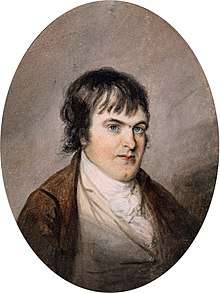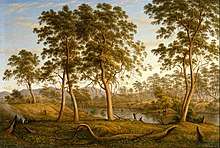John Glover (artist)
John Glover RBA (18 February 1767 – 9 December 1849) was an English-born Australian artist during the early colonial period of Australian art. In Australia he has been dubbed "the father of Australian landscape painting".
John Glover | |
|---|---|
 John Glover | |
| Born | 18 February 1767 |
| Died | 9 December 1849 (aged 82) |
| Nationality | |
| Education | Free School, Appleby |
| Known for | Landscape |
Notable work | 'Hobart Town, taken from the garden where I lived', 1832[1] 'Mount Wellington and Hobart Town from Kangaroo Point' 1831–33[2] 'Natives on the Ouse River, Van Diemen's Land', 1838[3] 'Natives at a corrobory, under the wild woods of the Country [River Jordan below Brighton, Tasmania]', ca. 1835[4] 'A view of the artist's house and garden, in Mill's Plains, Van Diemen's Land', 1835[5] |
| Movement | Claudean style, picturesque |
| Spouse(s) | Sarah |
| Awards | Louis XVIII gold medal (for 'Bay of Naples') |
Life in Britain
Glover was born at Houghton-on-Hill in Leicestershire, England. His parents were farmer William Glover and Ann (née Bright). He showed a talent for drawing at an early age, and in 1794 was practicing as an artist and drawing-master at Lichfield.[6] The Countess of Harrington helped establish his practice as an art instructor, and may have taken lessons from him herself.[7] He moved to London in 1805, became a member of the Old Water Colour Society, and was elected its president in 1807. In the ensuing years he exhibited a large number of pictures at the exhibitions of this society, and also at the Royal Academy and the Society of British Artists. He had one-man shows in London in 1823 and 1824. He was a very successful artist and, although never elected a member of the Academy, his reputation stood very high with the public.
Glover achieved fame as a painter of "Italianate" romantic landscapes of Britain (including The falls of Foyers on Loch Ness, the Lake District and London) and Southern Europe. He became known in both England and France as the English Claude. This phrase was making comparison with Glover and the French seventeenth century artist Claude Lorrain, whose works collected by eighteenth century English "grand tourists", strongly influenced the evolution of the English style, in both painting and the layout of landscape gardens.[8]
On 21 October 1825 Glover was one of three passengers on PS Comet II who alighted at Rothesay, thus escaping the disaster which occurred to the paddle-steamer a few hours later when it was hit by SS Ayr and sank in the River Clyde with the loss of 62 lives.
Arrival in Australia
Glover decided to move to Australia, arriving in Van Diemen's Land (now Tasmania) on his 64th birthday in 1831.[6] He brought with him a strong reputation as a landscape painter. From April 1831 until early 1832 he lived in Hobart on a property named "Stanwell Hall", which can be seen in his work Hobart Town, taken from the garden where I lived. In 1832 he acquired one of the largest grants of land in Van Diemen's Land at the time at Mills Plains, Deddington. He named his new property Patterdale after Blowick Farm, a property near Patterdale, at the foot of Ullswater in the Lake District. Glover's grant placed him in close proximity to Kingston, the home of John Batman (later to co-found Melbourne) and his relationship to his neighbour appears to have been fraught.[9] Glover helped build the Chapel at Deddington and is buried within these grounds.[10]
Art in Australia


Glover is best known now for his paintings of the Tasmanian landscape.[11][12] He gave a fresh treatment to the effects of the Australian sunlight on the native bushland by depicting it bright and clear, a definite departure from the darker "English country garden" paradigm. Note this example Patterdale Farm (circa 1840).[13]
His treatment of the local flora was also new because it was a more accurate depiction of the Australian trees and scrubland. Glover noted the "remarkable peculiarity of the trees" in Australia and observed that "however numerous, they rarely prevent your tracing through them the whole distant country".
Natives on the Ouse River, Van Diemen’s Land (1838)[14] is "informed by European notions of an Antipodean Arcadia, with Indigenous people living in a landscape unsullied by European contact."[6] However, it stands in marked contrast to the actual situation of the traditional owners of Ouse River country - the Braylwunyer people of the Big River nation - which was one of dispossession and violence at the hands of the colonists.[14] John Glover's last major work was painted on his 79th birthday.
Australian legacy
The John Glover Society was established on 22 August 2001 to honour and promote Glover's memory and his contribution to Australian art. The society commissioned a life-size statue of Glover, unveiled in February 2003 in Evandale, Tasmania.[15] It also runs the annual Glover Prize, which is held in Evandale.[16]
John Glover's work features in many prominent art galleries throughout Australia (and the world). His work has been the subject of numerous exhibitions[17] and a symposium in Australia.[18]
From 2004, The John Glover Society has awarded the Glover Prize for depictions of Tasmanian landscapes. It is the richest art prize in Australia for landscape painting.[19][20]
In 2019, the farmhouse once occuplied by the Glover family, southeast of Launceston, was restored and 400 ha (990 acres) of surrounding land, which frequently featured in Glover's work, was heritage listed as 'Patterdale and Nile Farm'.[21]
See also
- Visual arts of Australia
References
- "Hobart Town, taken from the garden where I lived, 1832". State Library of New South Wales. Retrieved 10 December 2017.
- "Mount Wellington and Hobart Town from Kangaroo Point, 1831-33". National Gallery of Australia. Retrieved 12 March 2015.
- "Natives on the Ouse River, Van Diemen's Land, 1838". Art Gallery of New South Wales. Retrieved 12 March 2015.
- "Natives at a corrobory, under the wild woods of the Country [River Jordan below Brighton, Tasmania], ca. 1835". State Library of New South Wales. Retrieved 12 March 2015.
- "A view of the artist's house and garden, in Mill's Plains, Van Diemen's Land, 1835". Google Art Project. Retrieved 12 March 2015.
- "John Glover". AGNSW collection record. Art Gallery of New South Wales. Retrieved 20 April 2016.
- "Jane Fleming, later Countess of Harrington". Huntington Library. Archived from the original on 17 February 2015.
- John Glover Society (10 May 2006). "About John Glover". Glover Prize. Archived from the original on 27 April 2006. Retrieved 25 May 2006.
- Campbell, Alastair (1987). John Batman and the aborigines. Malmsbury, Vic: Kibble Books. ISBN 0908150083.
- "Deddington Chapel". Evandale Tourism. Retrieved 3 December 2014.
- Glover, John; Hansen, David, (author.); Tasmanian Museum and Art Gallery (issuing body.) (2003), John Glover : the Van Diemen's Land sketchbook of 1832-1834, Hobart, Tasmania Tasmanian Museum and Art Gallery, ISBN 978-0-9750545-3-6CS1 maint: multiple names: authors list (link)
- Glover, John. "John Glover sketchbooks and portfolio of sketches, ca. 1794-1835". State Library of New South Wales. Retrieved 2 February 2018.
- Glover, John (c. 1840). "Patterdale farm". AGNSW collection record. Art Gallery of New South Wales. Retrieved 7 February 2013.
- Glover, John (1838). "Natives on the Ouse River, Van Diemen's Land". AGNSW collection record. Art Gallery of New South Wales. Retrieved 7 February 2013.
- "The John Glover Society". John Glover Society. Archived from the original on 12 March 2015. Retrieved 12 March 2015.
- "The Glover Prize". John Glover Society. Retrieved 12 March 2015.
- Glover, John; McPhee, John (John A.), (author.); Queen Victoria Museum and Art Gallery (Launceston, Tas.); Queensland Art Gallery; Art Gallery of New South Wales (1977), John Glover, Launceston [Tas.] Queen Victoria Museum and Art Gallery, ISBN 978-0-7246-0330-5CS1 maint: multiple names: authors list (link)
- Glen Mulcaster (23 March 2004). "Following Glover's footsteps". The Age. Melbourne. Retrieved 25 May 2006.
- "Tasmanian wins Glover landscape prize". ABC News. Australian Broadcasting Corporation. 10 March 2006. Retrieved 20 March 2012.
- "Martin Bryant painting wins Glover prize". ABC News. Australian Broadcasting Corporation. 9 March 2012. Retrieved 20 March 2012.
- Kelly, Margot (12 October 2019), "Inside the working farm that inspired the father of Australian colonial art, John Glover", Landline, Australian Broadcasting Corporation, retrieved 13 October 2019
- Serle, Percival (1949). "Glover, John". Dictionary of Australian Biography. Sydney: Angus and Robertson.
External links
| Wikimedia Commons has media related to John Glover. |
- John Glover at the Art Gallery of New South Wales
- "Australian Painters". Australian Government Culture and Recreation Portal. Archived from the original on 5 February 2010. Retrieved 25 May 2006.
- Italian Landscape 1841 - in Ballarat Fine Art Gallery
- Bernard Smith, 'Glover, John (1767 - 1849)', Australian Dictionary of Biography, Volume 1, MUP, 1966, pp 455–456.
- John Glover at Australian Art

Glover, John (1767-1849) in libraries (WorldCat catalog)